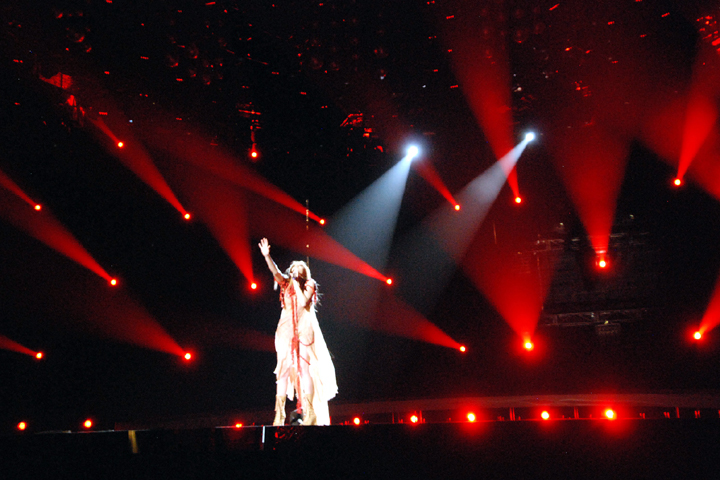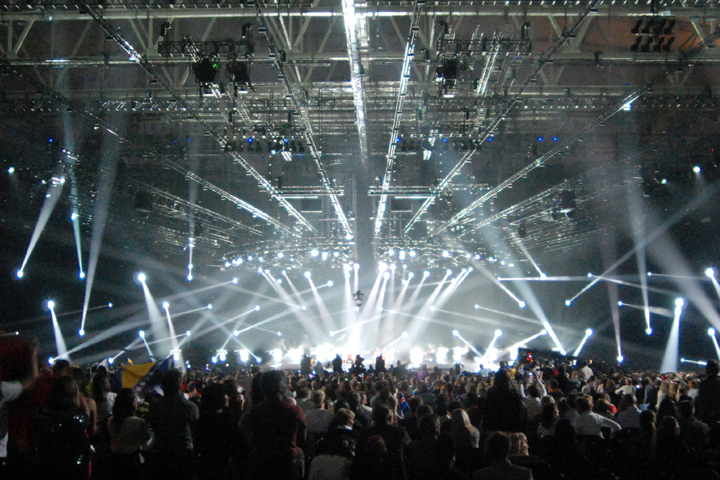The 2010 Eurovision Song Contest in Oslo, Norway brought a worldwide audience ‘back to the basics’ with Lighting Designer Al Gurdon’s stunning array of layered effects, including 88 Clay Paky Alpha Spot HPE 1200 fixtures.
The Alpha Spot fixtures were right in the middle of the action, with the highest number of profiles used on the show. They were built into alternating positions with Jarag units to make up one of the giant walls which could move up or down via Kinesys motion control. The entire back wall was pre-fabricated with custom designed brackets at PRG Birmingham and shipped to Oslo. Other “layers” included a wall of Colour Block low-resolution LED fixtures, a 3D curtain of 2000 XL X-Balls over the centre of the stage, and other textural elements such as choucroute, Deko silk drapes, a starcloth curtain and a kabuki drop. PRG with support from Frontlite provided all technical equipment and crew for the show.
The Alpha Spot fixtures gave particular flair in the songs for Slovenia, Bosnia and Herzegovina and especially Ukraine, where the fixtures were programmed into a hypnotizing wave that was actually used in the official stage design release to the press on April 6. Andy Voller controlled all moving lights on a PRG V676 console. “The configuration of the Alpha Spots allowed for some excellent effects. The songs that featured them definitely made a powerful statement.”
With the theme for this year’s show being “Share the Moment”, a key element was the ability to include the audience with whatever happened onstage, as part of the televised experience. Gurdon explains, “The lighting design for Eurovision 2010 was based on the need for flexibility; to create a sufficient variety of visual moods and textures to underpin the tones of the musical performances; grand scale; to suit the size and setting of the show, as well as the expectations of its audience; and the need to include the audience and the arena as part of the televised experience.”
He continues, “To this end, the approach to the lighting design has been, simultaneously, a movement ‘back to basics’, but with a ‘state of the art’ approach to the use of lighting technology. The goal is that everything will feel connected. In addition to nearly 2000 Colour Blocks, we have a back wall containing 88 Alpha Spot HPE 1200 along with 80 Atomic Strobes and 80 Chromalect ‘Jarag’ units, and for lightning effects we have seven 85KW Hungaro Flash.”
Of the Clay Paky units, Gurdon added, “The Alpha Spots looked great. The units are fast and bright but also dependable, which is really important when we’re dealing with so many fixtures and working in a very tight schedule. I was very pleased.”
This was the 56th year for Eurovision, held at Norway’s Telenor Arena to a live audience of 18,000 and an estimated 200 million television and internet viewers. This year saw 39 competing countries broadcast live in two Semi-finals on May 25 and 27 and the Finals on May 29.
The event was televised by host broadcaster, NRK with a largely Norwegian production team working under the leadership of executive producer, Jon Ola Sand and TV producer, Hasse Lindmo. Production Manager of Design was Ola Melzig assisted by PRG Project Manager Matthias Rau. Stage design was by Kirsten Weltzin, Bonsak Schieldrop, Trond Olav Erga and Audun Stjern.
Melzig, commented: “The Alpha Spots looked phenomenal. Their reliability is always important, especially the way they were used this year – front and centre. Even one failure would have been very obvious. Thanks to their punch, speed and features along with Andy’s programming, they added a very dynamic layer to the songs they were used in.”
Pio Nahum, Clay Paky Sales and Marketing Manager said, “We are very proud of the work that the Eurovision lighting team did. It is prestigious show that provides a lot of visibility and we are glad that PRG wanted to use Clay Paky fixtures. We are enjoying a very successful partnership with them and look forward to more great things together.”
The end of the voting saw Lena Meyer-Landrut of Germany crowned winner with 246 points for her hit smash “Satellite”.








